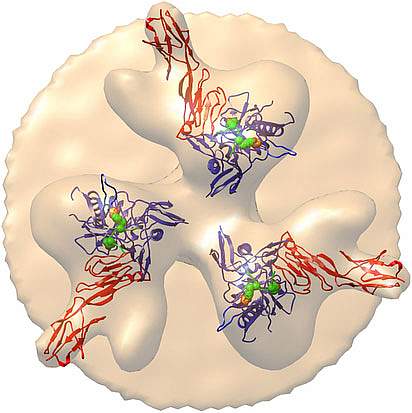You are here
March 9, 2015
Compound May Protect Against HIV
At a Glance
- Scientists created a compound that can protect against a wider range of HIV strains than any previous approaches.
- The new molecule could potentially lead to a long-lasting method of HIV prevention and treatment.

HIV has proven stubbornly resistant to potential vaccines. Most vaccines work by triggering the immune system to produce antibodies that help beat back infections. But proteins on HIV’s surface mutate rapidly and change shape continuously. These quick transformations keep most antibodies from latching onto and neutralizing the virus.
Researchers have found antibodies that can neutralize many different strains of HIV. These broadly neutralizing antibodies bind to small unchanging regions of the HIV envelope protein Env. But strategies to make vaccines that prompt the body to produce antibodies against these regions have had limited success.
A team of researchers led by Dr. Michael Farzan of the Scripps Research Institute took a novel approach to try to protect against a wide variety of HIV viruses. All HIV strains infect cells by attaching to the CD4 protein on the surface of target cells. The virus also must bind to another cell protein, called a coreceptor, to gain entry. Most HIV strains use the protein CCR5 as a coreceptor. Once HIV binds CD4, it changes shape to expose the part of the virus that binds CCR5.
Armed with this knowledge, the researchers decided to create a fusion protein with a form of CD4 on one end and a crucial piece of CCR5 on the other. This fusion protein, called eCD4-Ig, might potentially block both points of viral binding. The study was funded by NIH’s National Institute of Allergy and Infectious Diseases (NIAID) and National Cancer Institute (NCI). Results appeared online in Nature on February 18, 2015.
In lab experiments, eCD4-Ig inhibited more strains of HIV with greater efficiency than any known broadly neutralizing antibody. When the researchers tested the compound in a mouse model of HIV infection, the mice were protected from infection.
The researchers next tested whether eCD4-Ig therapy could protect rhesus macaques from an HIV-like virus called SHIV, which infects monkeys. The team inserted a gene that codes for the eCD4-Ig protein into a harmless virus, or vector. When injected into 4 monkeys, the vector infected the animals’ cells and caused them to produce eCD4-Ig.
These treated monkeys were then exposed to SHIV. All of the animals remained healthy 6 weeks after the final SHIV injection. In contrast, all 4 untreated animals became infected after exposure to SHIV.
“Our compound is the broadest and most potent entry inhibitor described so far,” Farzan says. “Unlike antibodies, which fail to neutralize a large fraction of HIV-1 strains, our protein has been effective against all strains tested, raising the possibility it could be part of an effective HIV vaccine alternative.”
With further development, this compound could potentially be used as both a preventative drug and as a treatment. Various technical and safety issues will need to be addressed before it could be tested in people.
Related Links
- Toxin Kills HIV-Infected Cells
- Vaccine Clears Away Monkey AIDS Virus
- Key HIV Protein Structure Revealed
- HIV Protein Strikes a Fleeting Pose
- Clues to HIV Protection
- HIV/AIDS
- Gene Therapy
References: AAV-expressed eCD4-Ig provides durable protection from multiple SHIV challenges. Gardner MR, Kattenhorn LM, Kondur HR, von Schaewen M, Dorfman T, Chiang JJ, Haworth KG, Decker JM, Alpert MD, Bailey CC, Neale ES, Fellinger CH, Joshi VR, Fuchs SP, Martinez-Navio JM, Quinlan BD, Yao AY, Mouquet H, Gorman J, Zhang B, Poignard P, Nussenzweig MC, Burton DR, Kwong PD, Piatak M, Lifson JD, Gao G, Desrosiers RC, Evans DT, Hahn BH, Ploss A, Cannon PM, Seaman MS, Farzan M. Nature. 2015 Mar 5;519(7541):87-91. doi: 10.1038/nature14264. Epub 2015 Feb 18. PMID: 25707797.
Funding: NIH’s National Institute of Allergy and Infectious Diseases (NIAID) and National Cancer Institute (NCI).
